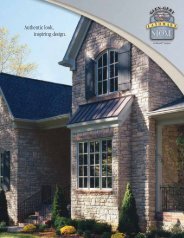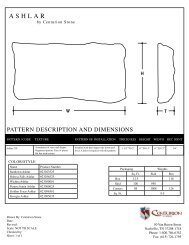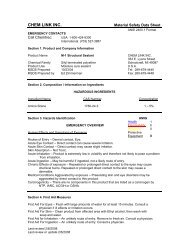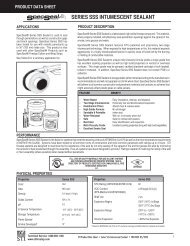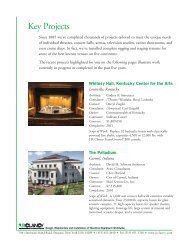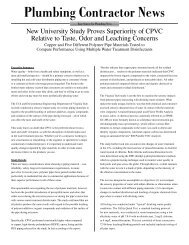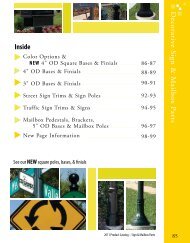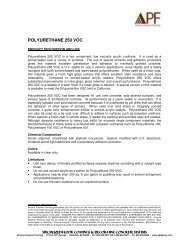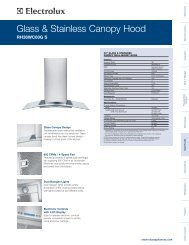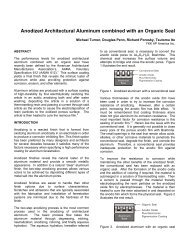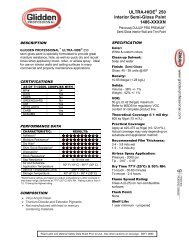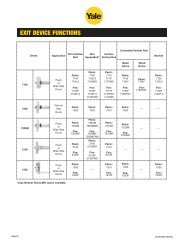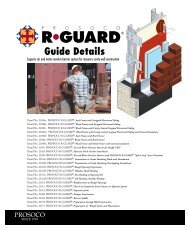Geoweb Earth Retention System Case
Geoweb Earth Retention System Case
Geoweb Earth Retention System Case
Create successful ePaper yourself
Turn your PDF publications into a flip-book with our unique Google optimized e-Paper software.
case study 1<br />
tAnner/Moffett Creeks • the dalleS, OregOn • fall 1998<br />
awarded 1999 induStrial fabriCS aSSOCiatiOn award Of exCellenCe<br />
The Challenge<br />
A plan to connect two sections of an old highway right-of-way in the<br />
Columbia River Gorge area included a section that would become<br />
part of a 100-mile bike and pedestrian pathway from Portland to The<br />
Dalles. Oregon DOT faced a considerable challenge of designing<br />
a series of switchbacks to gradually bring the bike path from the<br />
highway down to creek level and pass under I-84. Retaining wall<br />
case study 2<br />
The Challenge<br />
Signs that the soil behind an existing aging sheet pile wall supporting<br />
Broadmoor Road and an adjacent railroad track was moving forced<br />
the village of Bayside to seek a solution. Challenges included:<br />
1) building a 9-m (30-ft) high structure across a 56-m (185-ft) wide,<br />
steep, wooded ravine with limited site access, 2) minimizing the size<br />
of the footprint to reduce impact on a stream flowing through the<br />
culverts, and 3) having the ability to support natural vegetation to<br />
blend with the surrounding ravine.<br />
Using granular soil and geogrid layers, a reinforced earth<br />
embankment was built with the <strong>Geoweb</strong> ® system facia and a front<br />
face batter of 0.75h:1v.<br />
The InsTallaTIon<br />
Each 8-cell wide<br />
by 3-cell<br />
long <strong>Geoweb</strong><br />
section was<br />
specified with<br />
a green facia panel and perforated interior cells<br />
to improve drainage and increase frictional<br />
interlock between the cells and the infill. Biaxial<br />
geogrid was sandwiched between the cellular<br />
layers every fourth course as a reinforcement<br />
layer. A trackhoe and clamshell bucket were<br />
Project photos courtesy Soil Stabilization Products Co.<br />
broadmoor road • baySide, wiSCOnSin • September 2000<br />
structures were necessary to<br />
keep the newly steepened<br />
side slopes in place. A<br />
vegetated facia was desired<br />
to blend naturally with an<br />
environment that provides spectacular views of the river and<br />
Cascades. A geocomposite solution combining the <strong>Geoweb</strong> ®<br />
system with high-strength woven geotextile soil reinforcement<br />
was chosen.<br />
The InsTallaTIon<br />
Six wall structures were required, one over 5 m (16 ft) in<br />
height. Green outer face panels blend naturally with the<br />
surrounding landscape. Perforated interior cell walls allowed<br />
drainage of the infill material. To establish vegetative cover<br />
quickly, ODOT hydroseeded the completed walls.<br />
The ResulTs<br />
After installation, a substantial natural spring was discovered<br />
behind one wall. Lower outer facia panels were simply<br />
removed, exposing the perforated interior cell walls and<br />
allowing drainage without damage to the wall structure. A<br />
drainage system was later installed to reduce the potential for<br />
hydrostatic pressure buildup.<br />
used to place infill on the lower<br />
wall layers. On the upper layers,<br />
infill was dropped some 3-3.7 m<br />
(10-12 ft) from the road above<br />
by a front-end loader.<br />
The ResulTs<br />
Project photos courtesy GeoSynthetics, Inc.<br />
The finished structure included a four-pipe culvert to increase<br />
stormwater flow capacity through the embankment. The wall<br />
measured 20 m (65 ft) wide at the base, 56 m (185 ft) wide<br />
at the top with 381 face m2 (4,100 face ft2). The finished<br />
embankment was hydroseeded with a mixture of annual rye<br />
cover, prairie grasses and flowers. All involved parties agreed<br />
that this vegetated geocomposite wall system was a success.





